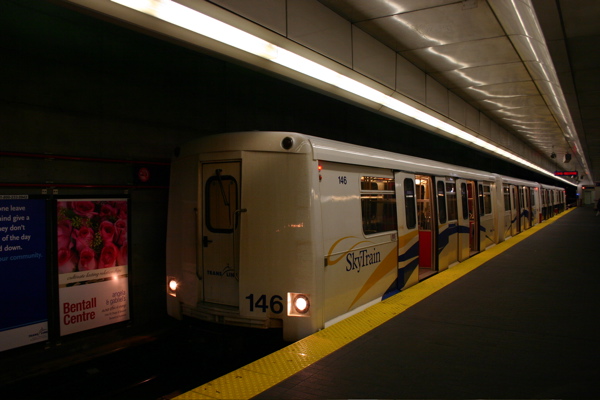
Visualisation of STA buses in Sydney at 9:01AM on a typical weekday. The bright vertical line in the middle is the Harbour Bridge. (Source: Flink Labs)
Some interesting time lapse visualisations of commuter transport from around the world. All of these show vehicle movements (trains, buses, etc), as opposed to passengers movements, unless otherwise stated.
Sydney
This first video is STA buses only. That means the government Sydney Buses, as well as the Parramatta-Liverpool T-Way buses. Despite the limitations of its data, and that it is now a few years old, it’s also quite clear and easy to watch.
Major corridors like Anzac Parade, Oxford Street, Parramatta Road, Victoria Road, and Military Road stand out quite well. They are the brightest during the day, and the only ones still operating late into the night. By showing busier corridors as brighter, you really get a good idea of what frequent services look like, as opposed to a bus map where all lines look the same.
This is another video of Sydney. It is more recent, includes all modes of public transport, and goes out as far as Newcastle and Wollongong. Trains are shown in the same colour as the line they operate on. It’s also a bit crowded, and harder to follow than the previous video, so it’s recommended that you watch it directly on Youtube with the settings set to 720p(HD) for better quality if it doesn’t do so automatically here.
Melbourne
A similar video to the earlier Sydney bus video, but this time from Melbourne for trains. Blue is for city bound, while yellow are outbound.
Auckland
This video was created by Chris McDowall, but the blog post associated with it no longer appears to be working. So instead, here is a short piece about it from Human Transit, in which the vehicles are described as “tadpoles”.
London
This video is from an article over at the Atlantic Cities, which is worth a read for some background. This shows passenger movements via the collection of Oyster smartcard data. Inbetween the morning and evening commute, passangers are shown as a red dot while at work.
New York City
This video of New York City includes the subway and bus system, as well as some longer distance commuter rail trains (these are most noticeable in Long Island on the right hand side of the map which is otherwise mostly blank). New York has one of the few transport systems in the Western world that runs 24/7 at decent frequencies, with most subway lines running at 20 minute frequencies all night. You can see this in the video, as unlike other cities here where transport is almost non-existant between 2AM to 5AM, because at no point do the dots stop moving around. New York really is the city that never sleeps!
As with before, best seen on Youtube with 720p(HD) settings.
Washington DC
The Washington Metro trains are shown as the colour of their line, while buses are the white dots. Long distance commuter trains (mostly to the North of Washington) are large dots with a while tail. Once again, if it doesn’t show up well here, then try it on Youtube with the maximum 720p(HD) settings.
More videos
If you’re interested in seeing more, the second Sydney video, as well as the New York and Washington videos are from a group called STL Transit, and their Youtube page is full of many other videos. And for a more detailed description of their Vancouver video, make sure to check out the Human Transit post on that particular video.

